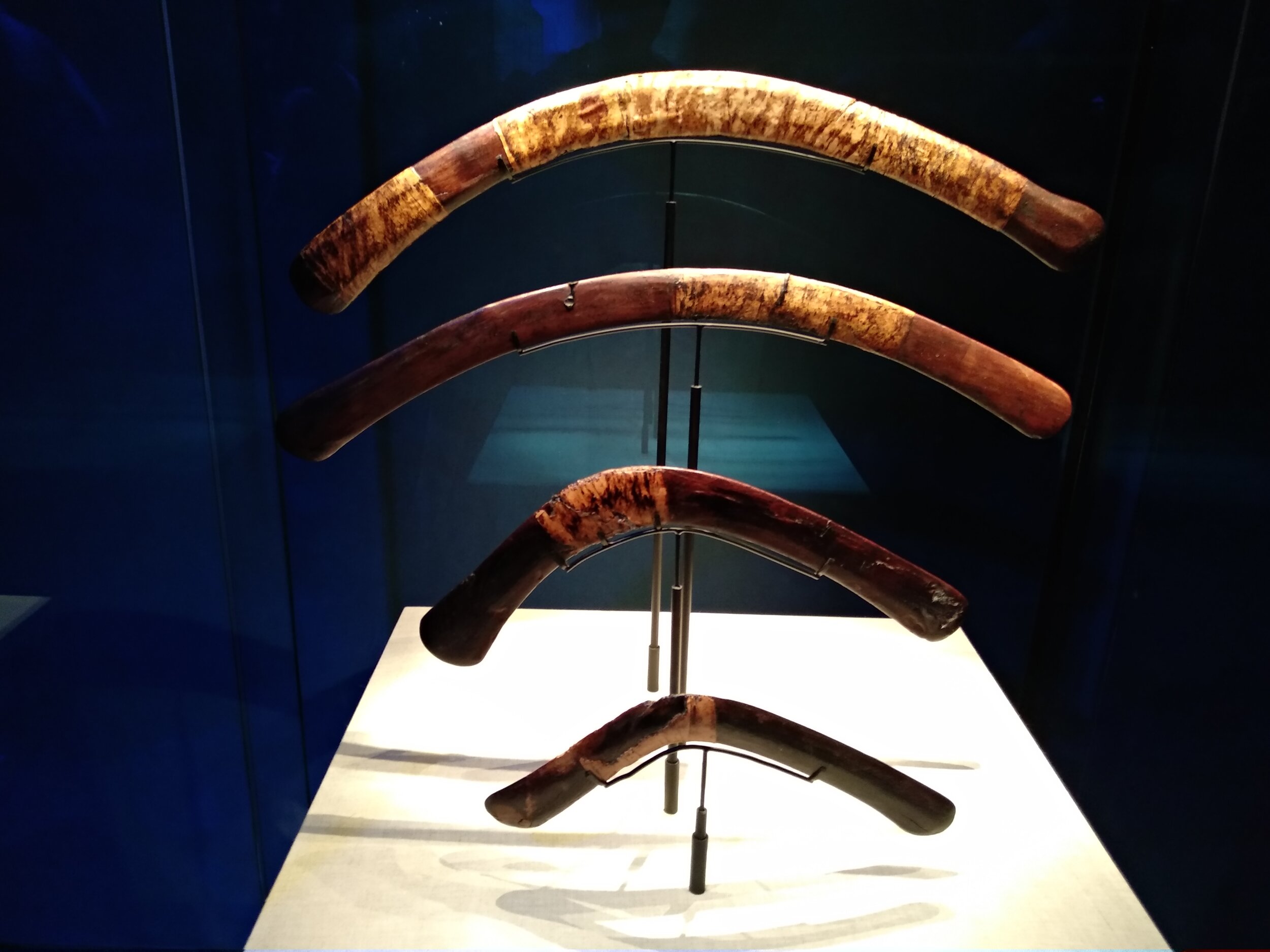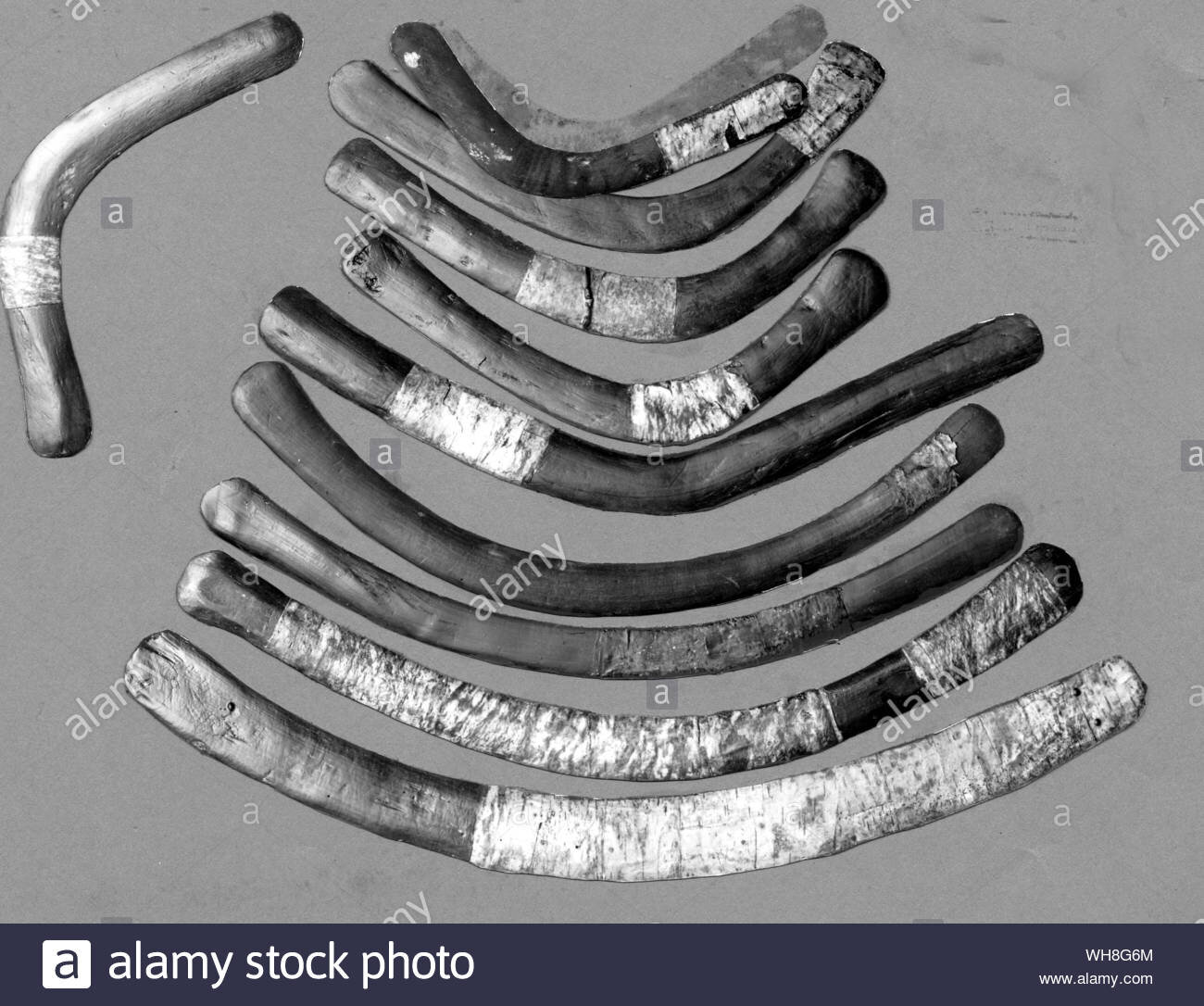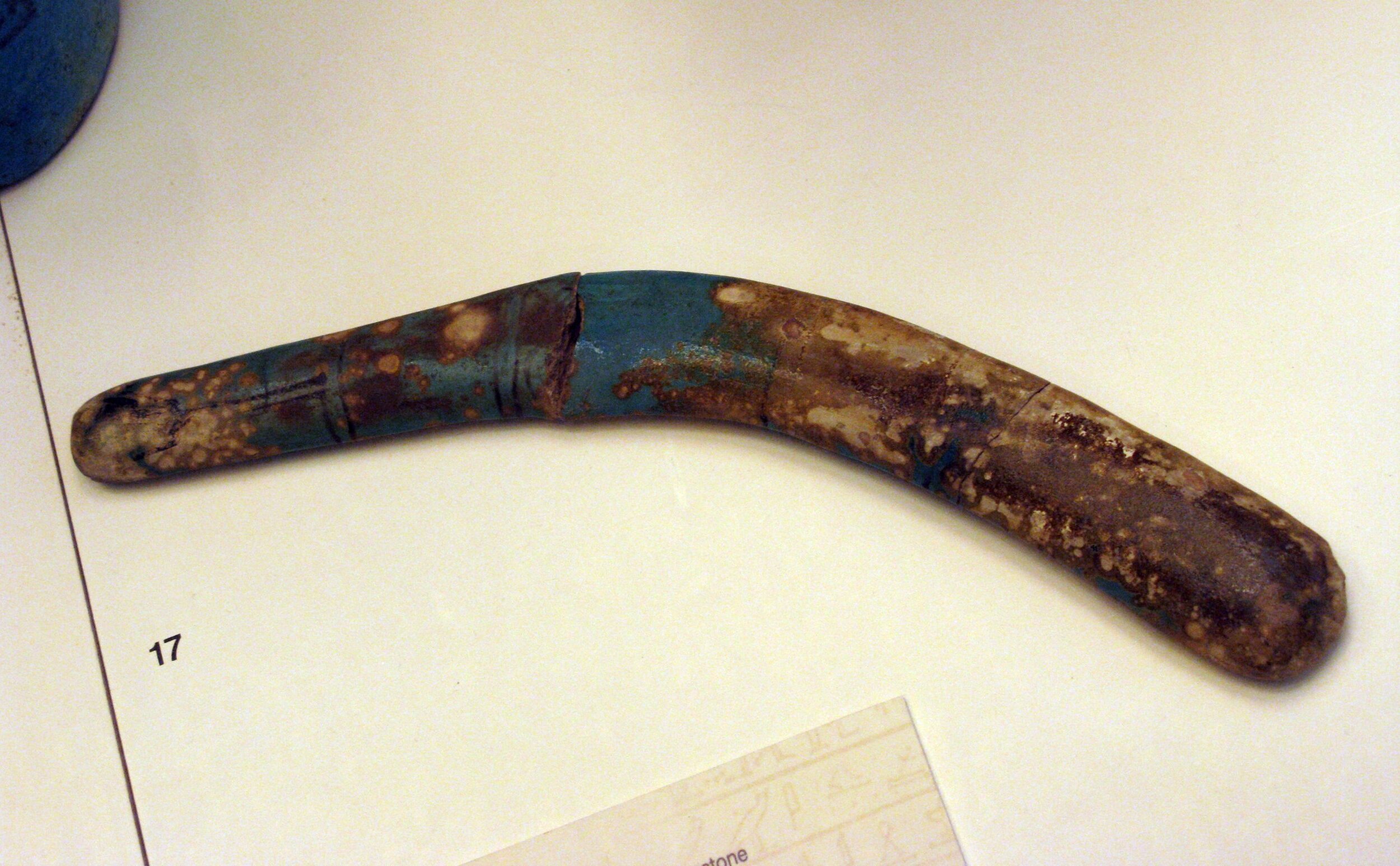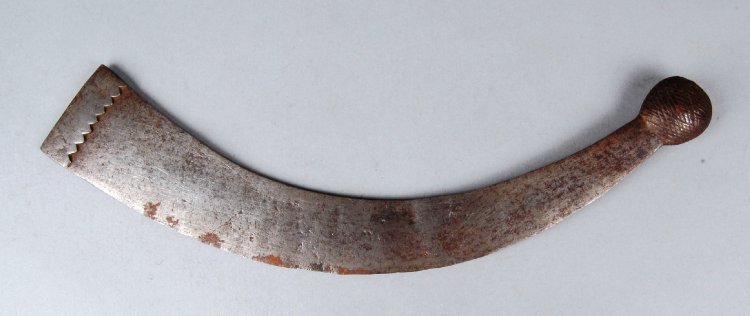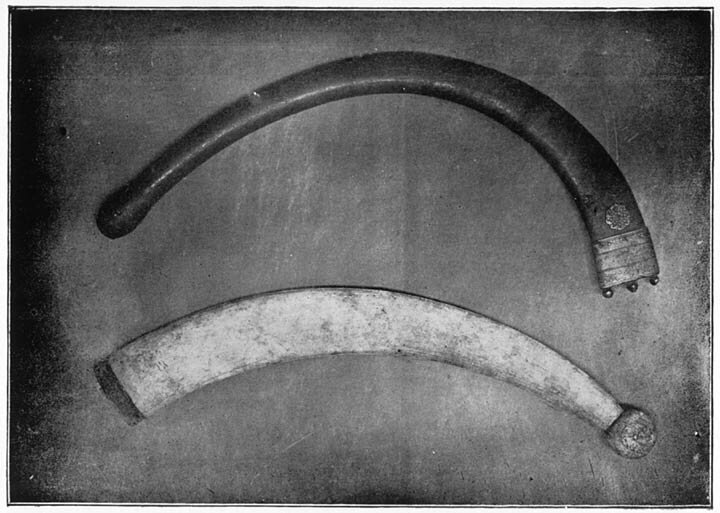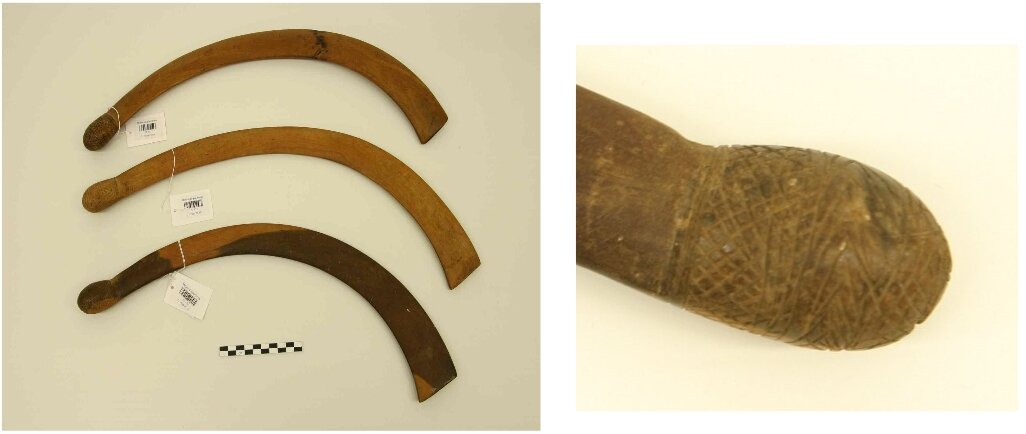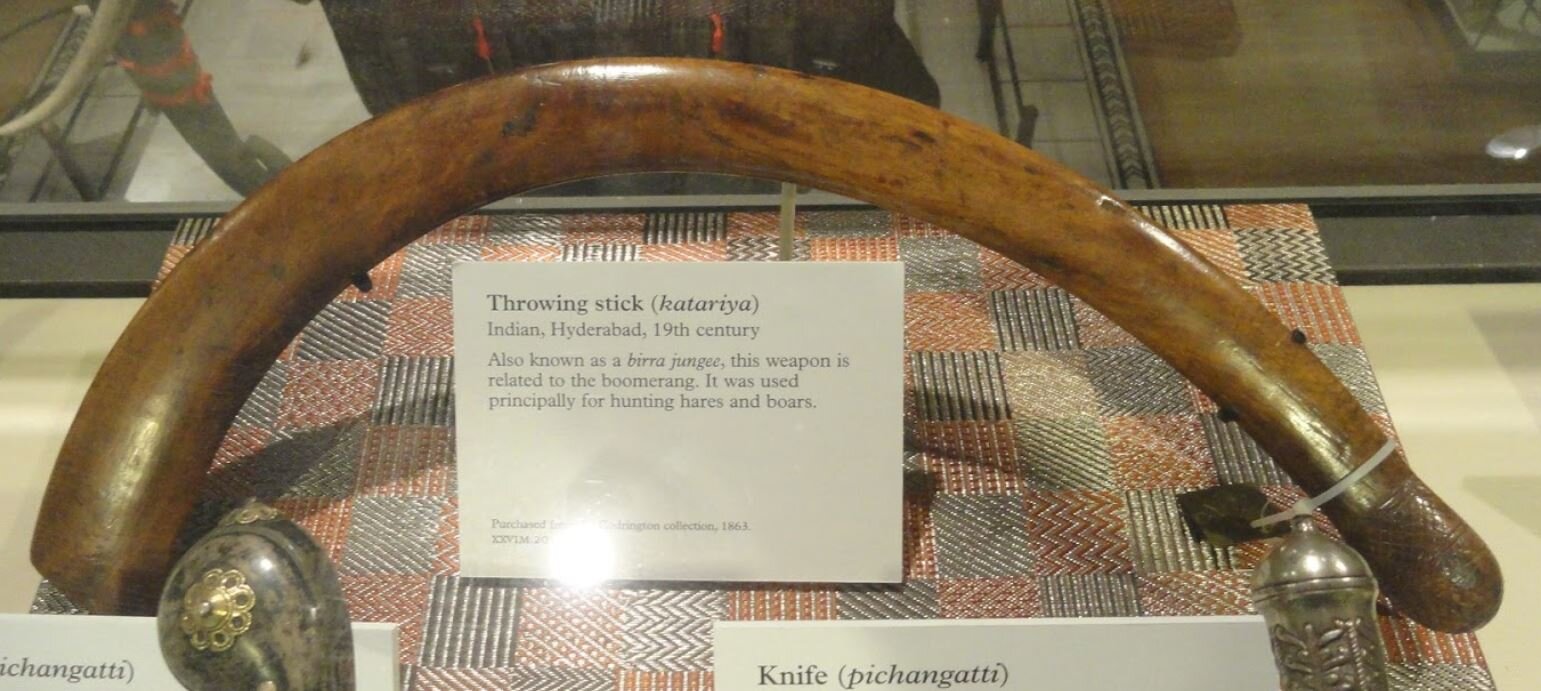The Boomerang belongs to us. Why have Scholar’s comparisons been so weak?
The invention of the Boomerang is no mystery. The original people of Australia's hands crafted this tool and weapon tens of thousands of years ago. Many interpretations of ancient Boomerang evidence and who created the object are based on suggestion and conjecture.
Photo from Karli Jalangu
Boomerangs are not just Projectile objects. Many projectile objects worldwide do not carry the significant attributes to be a Boomerang, and there is no continuous evidence or craft elsewhere around the world as in Australia. There are many different Boomerangs, clubs and other throwing sticks also found in Australia. Number [7] Boomerags(Hook Boomerangs) and Returning Boomerangs are unique designs and the mastery of Aboriginal people and hold an ancient cultural connection.
It is a myth that Captain James Cook recorded the name 'boomerang' for the first time. There is no record that he ever used the term or even saw a returning boomerang thrown, though he did take one back to England, thinking it was a primitive wooden sword.
“A few of the Indians who had not followed the boat remained on the rocks opposite the ship, threatening and menacing with their pikes and swords –two in particular who were painted with white, their faces seemingly only dusted over with it, their bodies painted with broad strokes drawn over their breasts and backs resembling much a soldiers cross belts, and their legs and thighs also with such like broad strokes drawn round them which imitated broad garters or bracelets. Each of these held in his hand a wooden weapon about 2 1/2 feet long, in shape much resembling a ‘scymetars’”
Joseph Banks diares. April 1770 - New South Wales
William Dampier also described Boomerangs in the same way in 1688. Boomerangs were referred to as ‘wooden swords’ for years after the British arrived, as found in the journals of Arthur Phillip (1789), Watkin Tench (1789) and surgeon John White (1790).
“The natives of this part of the country make use of a weapon which is not employed by and is even unknown to, the natives of Sydney. It is composed of a piece of wood in the form of a half-circle which they make as sharp as a sabreon both edges and pointed at each end. They throw it on the ground or in the air, making it revolve on itself, and with such velocity that one cannot see it returning towards the ground; only the whizzing of it is heard. When they throw it along the ground it is exactly like a cannon-ball, knocking down everything in its passage.”
1802 footnote by Francis Louis Barrallier
(H. Hatchet - S. Sword -Plate 37.) Implements of New South Wales John White, Journal of a Voyage to New South Wales, London, 1790
“The boomerang is a weapon with a very peculiar and curious shape. It is a piece of very hard wood, curved and about a metre long. It is from six to eight centimetres at its widest and becomes narrower on each side up to the point. The concave part is from four to eight millimetres thick, and the convex part is entirely sharp. An indigenous person can throw this instrument 40 or 50 metres, parallel to the horizon and skimming the ground without touching it at about one metre or one metre 30 centimetres elevation.
Then, at this distance, the boomerang suddenly rises in the air up to 50 to 60 metres and, describing a great curve, it comes back to fall at the feet of the individual who threw it. It thus comes back around on itself, rather like a billiard ball hit below its centre of gravity, goes away at first and then returns to its point of departure. The boomerang turns on itself with great rapidity during its flight, like a piece of wood on a pivot, and produces a whistling sound in the air. In the hands of a European, the boomerang is just a simple inoffensive stick, but this becomes dangerous for the person who wishes to use it without knowing how to do so” (1)
- Captain Abel Du Petit.
Aboriginal Nations across this landmass have many names for their unique craft; some are Karli, Kylie, and Wang-al.
What is a projectile object?
A throwing stick is pretty much any “stick” that is thrown by hand. A Boomerang is a unique projectile object in a class of its own, not just a throwing stick. Many articles written over the years about Boomerangs always use the term “throwing stick”. The Boomerang's unique craft and principles are diminished by just attaching it to such a loose category. The skills and attributes required to make a Boomerang are beyond any wooden throwing stick that some ancient ancestor cut off a tree and decided to carve one day. If Boomerangs are only throwing sticks, then they are the most creative and inspiring throwing sticks ever known to man, perhaps the reason so many are trying to claim they existed outside of Australia. These mysterious findings and suggestions of so-called Boomerangs are not confirmed by any substantial evidence showing manufacturing and use over lengths of time as seen embedded in the knowledge of the original people of Australia.
Aboriginal people introduced the Boomerang to Europeans on their arrival to Australia, and just like Aboriginal people’s land, the Boomerang also became an item of acquisition and appropriation, being displayed and sold as souvenirs for the tourist market ever since.
‘Pelaco Bill’ poster - Photo: James Northfield Heritage Art Trust, National Library of Australia, nla.pic-an7721244
The popularity of the Boomerang as a souvenir helped transform it into a national symbol and was branded as distinctly Australian — from brandy to butter, cigarette papers, flour, etc.
“Ever since their structure has been fully understood, carpenters appear to have ceased from all other work; the windows of toy shops exhibit little else: walking sticks and umbrellas have gone out of fashion, and even in this rainy season no man carries anything but a boomerang” (2)
Dublin University Magazine 1838
Common, Shelton & Co. 1907, Boomerang Australian brandy Common, Shelton & Co, [Melbourne]
No scholar wrote about Boomerangs being commonly known objects nor spoke of them as a study worldwide until Europeans arrived in Australia. Only then would Boomerangs be popularized and known to the world. Many other groups around the world had similar throwing or projectile objects, however, they do not carry the design and principles of a Boomerang. The Aboriginal introduction of Boomerangs to the world inspired writers and scholars once they had visited Australia. The knowledge many scholars gained from this original craft gave the world a better understanding of some of the principles of flight today.
Boomerang use around the world -
When we think about an ancient invention our minds often go straight to places like Egypt. A highlight of King Tut's famous collection of “throwing sticks” found in his tomb is a shining example. The evidence of human presence in Australia shows a culture alive and in full practice over ten times earlier than “Great Egypt”. Evidence that illustrates and demonstrates the craft of this ancient tool and weapon continuously over tens of thousands of years.
There were coins found in Queensland dating back to the time of Ptolemy IV in Egypt.
Coins from East Africa found in the Northern Territory dating back 900 years ago,
Unique stone engineering was accomplished in Australia 45,000 years before Egypt existed.
Stone carvings found in Australia were created 45,000 years before a Sumerian tablet text or Egyptian Hieroglyph was carved.
Could some sort of trade have happened long ago between the Egyptians and Aboriginal people? Possible, but why were there Boomerangs in King Tut's tomb?
Because they are not Boomerangs, they are Birth Tusks or wands (To ‘wand’ off evil). Or else you can call them “Clubs” or even “Throwing clubs” These items are not based on the principles nor hold the specific attributes to be Boomerangs though, nor were they purposely designed to be anything but a Wand/Club.
Principle of the Boomerang:
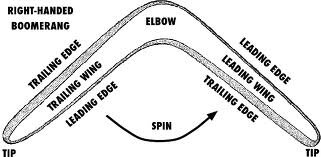
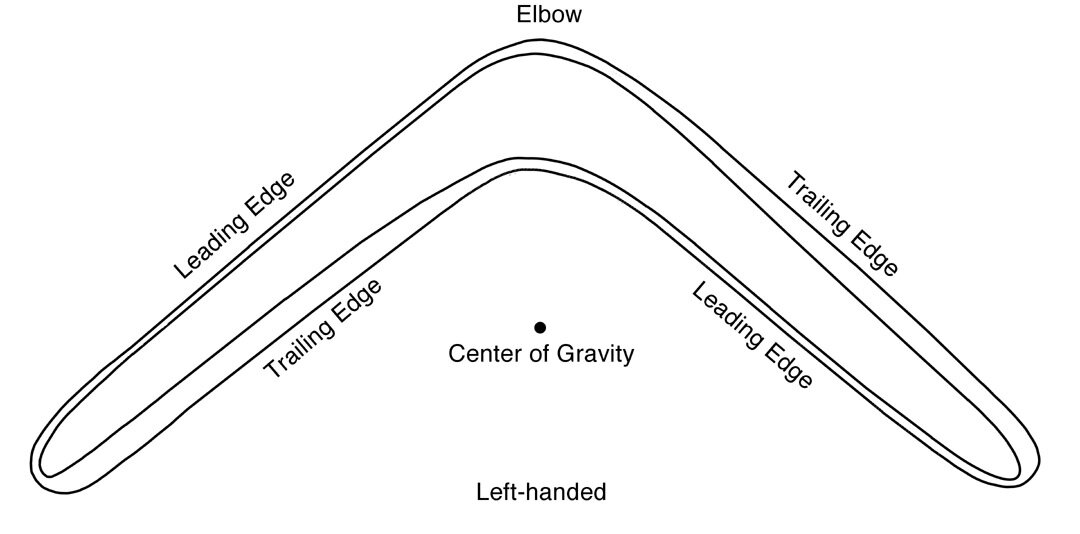
Boomerangs are aerodynamically shaped objects designed to fly efficiently through the air when thrown by the hand. Two design components give Boomerangs the capability of circular flight. One is the arrangement of the arms, and the other is the air-foil profile shape that allows the arms into wings. The wing profiles create the same lift effect that makes aeroplanes fly. During the flight, Boomerangs spin rapidly (about ten revolutions per second). In addition, the spinning motion creates gyroscopic precession, which pulls the Boomerang into a circular path.
The boomerang is one of Australia’s most unique and distinctive emblems. While most of us would imagine that a boomerang’s curve is essential for its flying properties, less well-known is that the surface shape of a boomerang’s arms are just as important.
Australian Museum
Noting the Attributes of the Boomerang
NASA’s new Aircraft Design. Image may be subject to copyright.
If a throwing object is to return, then gyroscopic precession and Airfoil design are attributes needed.
See NASA – Shape effects on the lift.
Also, read about their cool new Boomerang-Shaped Aircraft that could be the first to Fly on Mars.
Different groups worldwide crafted Clubs, wands, and throwing sticks. Individual ivory items were a feature in burials of the late Middle Kingdom in Ancient Egypt, like the one carved out of hippopotamus ivory. (3)
Baton magique en ivoire (Louvre, E 3614) 1By anonymous, Public Domain,
These items retain the shape of a hippopotamus tusk-line canine, making it easier to craft by the natural curve and point of the tooth to create the desired object.
The hippopotamus ivory is too rounded by being naturally shaped to the sharp point of the tooth and then curved all around the item not leaving a flatter surface. This would give the ivory a very different effect in flight if used as a projectile object. The key attributes are missing for it to be able to fly the same as a Boomerang, not to mention the possibility of breakage.
The Ancient Egyptian birth tusks belong to the Middle Kingdom and the Second Intermediate period.
Even the suggestion that the Saqqara bird was a model of thought for the glider is a leap, as it again does not hold the correct aerodynamic principles and is just a children's toy that could not fly without a motor.
Saqqara Bird Egypt - by Dawoud Khalil Messiha, Public domain, via Wikimedia Commons
Critically, these wands and throwing sticks found in King Tut's Tomb are what they say they are, and I am sure that the fact that they are not Boomerangs does not take anything away from the Egyptians.
The extent of these throwing clubs found in Egypt is a sample of the aboriginal Clubs, wands and collections of genuinely crafted Boomerangs found in Australia. Nowhere else in the world is there quite a collection.
Tamil Valari (India) -
Valari - is an ancient craft of the Tamil people living in the Indian subcontinent. Sometimes used in wars, but mainly to defend cattle from predators or for hunting, and was sometimes even fitted with blades.
Boomerang Tamil Poster - By Source, Fair use, https://en.wikipedia.org/w/index.php?curid=58523846
Most often, it was a blunt and heavy throwing weapon. Some have claimed it was the weapon of choice for war, but this seems more of an exaggeration and perhaps just an attractive theme for the next Tamil movie blockbuster.
The Valaris are not Boomerangs but another good example of crafting projectile objects by a culture. This fact does not take anything away from the Tamil people, their culture or their ancient craft of the Valari no more than it does the Wands/Clubs of the Egyptians. You can read in more detail about Valaris here > “This weapon is not a Boomerang”
Another throwing stick found was used by First Nation Americans for hunting small animals. Throwing objects similar to the Valari were discovered in Europe, including a 2000-year-old “thing” in France, quickly classed as a Boomerang.
2000 year old - Gaulish Throwing Stick from Normandy (France) Image may be subject to copyright.
These throwing sticks do not hold the attributes to be Boomerangs. There is no evidence of continuous use or advancement, just a couple more one-off items, as the experimental study on the Gaulish item suggests.
Is the oldest Boomerang in the world found in Poland?
Thirty years ago, archaeologists found a throwing stick made from a mammoth's tusk estimated to be up to 25,000 years old in the Carpathian Mountains that scholars announced was the oldest Boomerang in the world. It is a huge leap to class this item as the “Oldest Boomerang in the world” when it again does not hold the key attributes needed to craft a Boomerang, nor a demonstration of continuous use of that craft, such as recorded history, whether oral, written down, painted on Rock Art or carved in stone. Considering the Tusk of an animal is preserved longer than the wood of a Boomerang, there should be many other examples of mammoth tusk-throwing sticks found by now if this were a commonly known and used craft. After 30 years of suggestion, how does this one-time find overwhelm or diminish the significant continuous evidence of the Boomerang’s unique design and craft by the original people of Australia over tens of thousands of years?
Not only does the Polish item not hold the attributes to be a Boomerang, but the possibility of breakage of these Mammoth tusk items would make it a single or twice-used weapon if thrown. This can only suggest that the Polish item was simply a random one-off experimental tool using “Mammoth Tusk”, which was used for many tools by different groups during the ages in that climate. It is certainly not an aerodynamically designed item for hunting with power and precision or a weapon of choice.
If these throwing sticks were a commonly known craft for Europe, we should have seen it well designed and advanced by the Ostrogoths, Visigoths etc. It should be more than a suggested picture in a Sumerian text, Egyptian hieroglyph, King Tut's collection of throwing sticks, and the wands that invoke the goddess to protect women and children.
There should be well-designed examples of Boomerangs found in Europe and elsewhere, even made from Bronze and Iron, throughout world history.
These, never to be found again so-called Boomerangs that pop up outside of Australia are random throwing objects. A Boomerang is such a unique craft, and the principles of a Boomerang have not been advanced and embedded into these other cultures.
A returning Boomerang is a unique style or brand of Boomerang, demonstrating continuous generational precision design. The unique and perfectly crafted shape of returning Boomerangs crafted by aboriginal people show aspects of modern Aerodynamics that are rooted and deeply embedded in the culture. This generational knowledge and mastery have passed through the culture before man's memory. The brilliant aboriginal Inventor David Unaipon also had the concept for the helicopter based on the Boomerang 22 years before others.
Image may be subject to copyright.
“When I solved the flight of the boomerang...it seemed to me that I could do away with the preliminary run of the aeroplane, and make the machine rise direct from the ground. I know that certain laws on which I work have not been tried before, but I am quite sure I shall be successful. I am aware of the opposing forces; but I know what to do to overcome them”
David Unaipon
“David Unaipon (the Australian aboriginal who invented an improvement on the sheep-sheaf ing machine), is now at work on an invention to enable aeroplanes to rise vertically from the ground…it occurred to him that the principle underlying the fight of the boomerang might be applied to the aeroplane to do away with the preliminary run. He says that he thinks he has solved the problem. He is having constructed appliances to allow him to make conclusive trials.” (4)
Daily Telegraph. Melbourne, Thursday, July 30.
Read our full article on David Unaipon > here
Many of these wands and clubs found in Egypt and elsewhere are not Boomerangs and are simply throwing sticks, and perhaps some were hardly ever thrown. We certainly did not hear any comparisons of the Boomerangs to wands in Egypt by William Dampier and others when they arrived in Australia, as they spoke of them as swords for years after arrival.
William Dampier Is Shown A Boomerang(Image may be subject to copyright)
If a Boomerang and its valuable principle were a commonly known craft in Egypt at the time of the wands, we would have seen a more notable progression of a Boomerang's principles over time through Egypt. We may have even seen the hand glider designed much earlier or planes of the Wright brothers and Helicopters in the sky sooner.
Original evidence of creation, innovation, spiritual connection, and continuous use in Australia -
The Boomerang is an original tool, weapon and instrument that has many different names and stories. Aboriginal substantial evidence of creation and use stands well above the throwing sticks found elsewhere, as the culture and stories are still alive today, the oldest continuous culture in the world. (5)
Corroboree’ in the late 19th century (Mitchell Library, State Library of NSW – GPO 1 18775)
Creating the first innovation of propelled flight.
Boomerang types
Boomerangs are bound to the original people of Australia. You need help finding a collection demonstrating such ownership over an object's precision-crafted generational knowledge. The Oldest Boomerang found so far in Australia, luckily found in a swamp, is 10,000 years old, which preserved the wood. The rock art depictions of Boomerangs are up to 20,000 years old.
Boomerangs in Australia were for hunting and combat, but also as a cultural instrument; this includes returning Boomerangs which are not only toys. Taking the time to make a Boomerang with no cultural, hunting, or combat use would be pointless to Aboriginal people.
Hunting Boomerangs (Including returning Boomerangs)
Most Boomerangs do not return. The arsenal of Aboriginal Boomerangs and clubs is an original collection. Clubs had different uses and designs but were still only throwing sticks or handheld weapons compared to the Boomerang's unique design.
Image - South Australia Museum
The Killer Boomerang is used mainly for hunting and is the most commonly traded across Australia. The Aerodynamic Design of this Boomerang propels with force and precision and could kill an animal and break a leg, but it also flies higher than the Hook Boomerang. The Aerodynamic Design of the Killer Boomerang was the blueprint for the Returning Boomerang.
The Hook Boomerang [Number 7 Boomerang] originated in the Centre of Australia. This Boomerang was traded only to certain other surrounding areas. You do not find examples of this craftwork anywhere else in the world. Also not a returning Boomerang; it is, however, the most dangerous of all Boomerangs. It propels with such force and precision that no animal, person or shield can block or stop the effect of its impact. Also used in combat, an authentic original [Number 7] Boomerang is a rare and challenging craft. It is also still considered one of the most dangerous handheld weapons in the world. Many people are willing to pay a high dollar price to get their hands on a traditional [number 7], An essential to any collector of ancient weapons.
View the original [number 7] Boomerang making process here > Karli Jalangu – Boomerang Today
Making Boomerangs >
Returning Boomerang
Returning Boomerangs are also for hunting, not an impact weapon, but a tool of fright that would help trap prey by illusion. Commonly used for hunting Water Birds, in N.S.W, the original people used Fibres from the bark of plants like the Kurrajong (Brachychiton populneus) to make nets for bird traps.
Picture attribute - Australian National Botanic Gardens
They would tie the net across a river or stream, then fly Boomerangs over the top of a flock of birds. As a Boomerang hovers above, it would create the illusion of a Hawk flying over, forcing the birds downwards into the net.
Cultural Connection, Rock Art and Artefacts
The cross–boomerang was not for hunting but used to pass on a story. Think of it as a prop in a play. The Boomerang prop adds action and drama to the story so that the audience will remember that story more easily. Boomerangs have an ancient spiritual connection to the original people as an instrument for song, dance, and cultural practice. They also have a spiritual connection, the same as Christians have with the wooden cross. Boomerangs get handed down to the next generation through culture and lore. All Aboriginal ancient tools and weapons created over tens of thousands of years have spiritual and symbolic meanings.
Aboriginal people’s interpretation and connection to the "non-physical" overwhelms many non-indigenous people and science. The lore also contains verses that sometimes defy the known religious views imbued with understanding the "non-physical" today, and Aboriginal spiritual healing often gets passed off as 'Hocus Pocus', 'Mumbo Jumbo, ' superstition etc. Paintings and carvings on objects also hold spiritual connection and story. A spear or a Boomerang is not original or does not contain real power if it has not had elements of spirituality placed into the item by Aboriginal people.
Original Rock Art
With over 100,000 rock art sites across Australia, Boomerangs are well illustrated. There are also many unknown or unseen rock art sites. There are depictions of Boomerangs in Arnhem land N.T, In Carnarvon Gorge Qld and many more places across Australia. There are battle scenes in Rock Art that depict Boomerangs. Dates for some rock art sites in the Kimberley region still need to be confirmed after decades of research, and suggestion that they are some of the oldest examples of rock art in the world. (6) Many rock art sites are recent, still being studied, or not confirmed after years of research, such as the unique Kimberley Gwion Gwion Art. (7) The evidence now shows that the Aboriginal people did paint the unique style, not foreign visitors.
Carnarvon Gorge Rock Art Qld
Petroglyph sites across Australia that predate Ancient European Scribes also hold images of Boomerangs. The original people of Australia are also still here to explain their history and culture.
The Original people already inhabited arid Australia and as far as the Flinders Ranges (South Australia) over 50,000 years ago. (8) Kakadu - Western Australia, has one of the most extensive collections of artifacts, with dates up to 65,000 years old.
Victorian Collections - All rights reserved - Identifier 23423
The original people of Australia were master stone engineers and worked with various types of woods in crafting the Boomerang over such a long period. The 20,000-year images of Boomerangs found in rock art are a part of 100,000 rock art sites across Australia, more than anywhere else in the world. The number of Rock Art sites in excess is still unknown today, even tourists visiting Australia have stumbled across a new rock art site never seen before.
Most Rock Art sites are sacred and some are forbidden and not to be seen or shared outside of the Tribe etc. All of these points make it hard to know or pinpoint anything regarding the Boomerang, especially when Aboriginal people first crafted it. Although the Aboriginal occupation of 70,000 years stands out as the original home of the Boomerang.
Australia is still the world's number one spot for rock art, with many of these sites still needing more research, dates and settling of disputes.“The oldest Boomerang” being found in Poland is a dubious assumption. Privileging a 25,000-year-old piece of Ivory that does not hold the attributes of a Boomerang over a 10,000-year-old preserved wooden Boomerang, and +20,000 years of Boomerang rock art, culture and craft in Australia is a weak comparison, Not defining the difference between a basic throwing object, a wand and a club and calling a piece of Mammoth Tusk a “Boomerang” is a lazy effort. 70,000 years of occupation and culture already places the invention and craft of the Boomerang in Aboriginal people’s hands and in full view of the world.
The dubious assumptions or deliberate appropriations only attempt to subtract from or diminish the Aboriginal contribution to world history and “Science” through the unique crafting of Boomerang. As an Aboriginal person, I myself grew up hearing a common racist joke in Australia. ["What have your people ever done…You only invented a stick,"] I see this attitude still seems to float around today as I found it in a Meme.
Meme Center - Created by mustapan 2012
I find it humorous how the many discoveries of throwing sticks today quickly "claim" to be Boomerangs, yet the only evidence is a “Stick”.
If you enjoyed this article please share >
Footnotes:
(1) Dyer, Colin. “The Aboriginal People in Sydney as Seen by Captain Abel Du Petit-Thouars, 24 November to 9 December 1838.” Aboriginal History, vol. 40, 2016, pp. 207–214.
(2) A Literary and Political Journal, Volume 11 1838. - The Boomerang and its vagaries,page.168
(3) Birth tusks : the armoury of health in context - Egypt 1800 BC / Stephen Quirke ; including publication of Petrie Museum examples photographed by Gianluca Miniaci, and drawn from the photographs by Andrew Boyce.
(4) An Inventive Aboriginal - The Aeroplanes Rise. Daily Telegraph. Melbourne, Thursday, July 30.
(5) Korff, J 2020, How old is Aboriginal culture?
(6) Aboriginal artwork in the Kimberley could be among oldest in the world, scientists say” - ABC News
(7) Kimberley Echo - Researchers join Balanggarra people to look at rock art
(8) Hamm, G., Mitchell, P., Arnold, L. et al. Cultural innovation and megafauna interaction in the early settlement of arid Australia. Nature 539, 280–283 (2016). https://doi.org/10.1038/nature20125
Cover image may be subject to copyright.
Further Sources and Information links:
National Australia Museum - Earliest evidence of the boomerang in Australia
Upper Palaeolithic boomerang made of a mammoth tusk in south Poland - Nature
Griffith University - Impact Rock Art
ANU - Archaeologists find world’s oldest ground-edge axe in Australia
Oral History - How oral cultures memorise so much information and American Association for the Advancement of Science - Is an Aboriginal tale of an ancient volcano the oldest story ever told?
Video links -
Australian Aboriginal Documentary - Boomerang The Men of Fifth World Tribes Planet - https://www.youtube.com/watch?v=Le6t4y3Vdq0
Making Boomerangs the Mudburra-Jingili Way - https://www.youtube.com/watch?v=IO-4IQq-D44
Crookhat and the Kulunada [from the CAAMA Collection] - https://vimeo.com/ondemand/kulunada/157235068?autoplay=1


